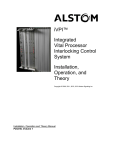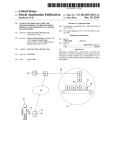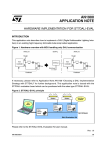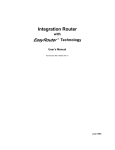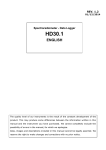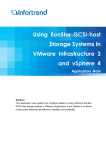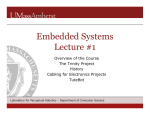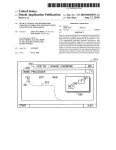Download Preparing for a Computer System In a Wholesale Fruit and
Transcript
Preparing for a Computer System In a Wholesale Fruit and Vegetable Company by Bruce E. Lederer Market Research and Development Division Agricultural Marketing Service U.S. Department of Agriculture A computer system is no longer a luxury for many fruit and vegetable wholesalers. With the complex interactions of buying and selling commodities at a rapid pace, along with the generally volatile nature of the business, wholesalers require a solution that will eventually automate most information flow procedures and improve decision-making capabilities. A computer system should satisfy most of the following general requirements: [1] Central storage of all relevant data - a data base. Accessibility of all data by key personnel. Ability of data entry the moment any transaction occurs, and instantaneous information retrieval. This is particularly necessary for inventory levels and prices. Reduction minimum. - Adequate security to protect computer system from physical damage, loss of data, and unauthorized access. The general objectives of a computer system used by fruit and vegetable wholesalers are twofold: ( 1) Less paperwork; less labor intensive functions; and faster, more accurate, and more productive processing of daily transactions; and (2) more accurate and sophisticated management information to the firm’s executives. The following information was developed as part of a larger research project [2]. Twenty wholesale fruit and vegetable firms were examined. Ten of these firms had manual operations and the remaining ten were computerized. Wholesalers should be aware of the areas discussed here before purchasing and implementing a computer system. of paper records to the bare Human Considerations Ability to track every transaction for audit purposes and for backup in case the system goes down. Control over the data entered its accuracy. to ensure Clear and accurate reports available in a timely fashion. Simple operation. Journal of Food Distribution Research People are a key element in the wholesale produce business and constitute one of the largest single costs of operations. Highly motivated employees are important sources of creative ideas, improved productivity, good customer relations, and ultimately, an effective organization. Traditionally, design concepts for computer systems depended heavily on a technical approach, Unfortunately, much of this tech- September 87/page 27 nical effort severely neglected the human factors. Consequently, human considerations are getting increased attention, even if these considerations do spoil those solutions that appear so ideally rational on paper. A successful computer implementation requires a balanced approach toward both technical and human needs. The following recommendations need to be considered before implementing a computer system Start small. Don’t overwhelm employees with a vast company-wide change. Introduce the new technology only to those areas where benefits are immediately needed and will be immediately evident. Present the new system as an aid to increased productivity and personal effectiveness, and not as a replacement for the present staff, Select a system that is compatible with the needs and preferences of the employees who will use it. Consult with employees before making a purchase decision. Provide training in the use of the new system both during and after the implementation phase, and don’t expect the training provided ● by the vendor to be toTrain only for that part tally adequate. of the system that individual employees need to know and only when they need to know it. The timing of training can be more important than the amount. Prepare employees for procedural changes and some reorganization, Show them how the pieces fit together and where there are important payoffs to the wholesaler and themselves. Appreciate the initial resistance from some employees. Senior workers who are more accustomed to the old manual methods will probably be most resistant to change. September 87/page 28 Be aware of the need for ergonomic inwith new technology. the tegration Ergonomics, the study of the relationship between humans and machinery, is a relatively new development in the office technology field. Office workers, the theory goes, will offer less resistance to products designed to be more compatible Familiar examples of with their needs. this type of design include tiltable video screens, screens adjustable for brightness, terminal keyboards that are detached and independent of the screen, proper lighting, and comfortable computer desks and chairs to minimize physical and mental fatigue. Choosing the Software Vendor Wholesalers need to determine their application software requirements before deciding on the hardware. Actually, most software vendors develop their software to operate compatibly with specific hardware; therefore, the choice of software usually determines the hardware that will be used. One way to check out a vendor’s package The system should is from demonstrations. satisfy the general requirements listed at the In addition to beginning of this article. watching, the wholesaler should use the keyboard for a hands-on demonstration and be aware of the potential simplicity with which employees (and management) can get their work done. Verifying the credentials of prospective vendors who are selling these products is critical. A quality computer system does not necessarily guarantee the quality of service provided by the vendor. Although the verif ication process is relatively simple, many wholesalers have been stuck with poor systems because they failed to evaluate their vendors beforehand. The best way this can be done is to speak with other wholesalers who are currently using the system. Although some excellent vendors have implementations in only one or two firms and cannot provide references, wholesalers additional should attempt to obtain at least a half-dozen and be certain that these references have systems similar to the one being examined. Journal of Food Distribution Research It is preferable that the wholesaler go to customer sites, see the system in action, ask all pertinent questions, and get, first-hand, the thoughts and feelings of those who are using the system and who are working with the vendor’s representative(s). Find out what problems they had and if What impact have they’ve been resolved. these problems had on the daily production work or decision support? Do the vendor’s representatives get along with the user’s personnel? Do they seem to know their product thoroughly, and can they communicate clearly with the user? Did it take long to learn the system well enough to become productive? Was their work seriously disrupted and for how long? All systems that have been successfully incorporated in wholesale produce companies have required additional customizing to satisfy individual wholesaler’s unique requirements and to satisfy additional requirements as wholesalers change and grow. Therefore, the wholesaler needs to know if the vendor has provided this support, the time it took to get the job done, their record in meeting deadlines, and whether a realistic schedule was provided. To summarize: - Does the vendor know the wholesale fruit and vegetable business, and does his product satisfy the wholesaler’s requirements? - Does the vendor know how to manage the installation and training for a wholesale organization? - Does the vendor appear to be a stable and good risk? - Does the wholesaler get a good feeling about the potential working relationship he and his staff will have with the vendor? Documentation for the Wholesaler Documentation is often neglected by suppliers of computer systems. The degree to which the wholesalers are supplied adequate Journal of Food Distribution Research documentation is the degree to which they will have confidence in the system and smooth daily operations. Several levels of documentation should exist for any system. The first is frequently referred to as the overview. This provides a flow of the entire system; that is, how the overall system works together to perform the functions of the organization. Each segment of the system is then taken separately and described. This usually includes a general description of each function, the input that is expected by the computer at each step, and the output that the worker can expect to receive at various times throughout the use of that program. Finally, a description should be provided of the layout of the files and the records that are kept in each file. For a modern system, this should be a database description. A second level of documentation is known as the source code. This is least likely to be supplied to the wholesaler. It is a technical level of documentation that is provided for the programmer who is responsible for supporting and maintaining the software. It is meant to provide in-depth descriptions of logic flow and coding (programming) that constitute the system, and it is not likely that this level of documentation will be provided to the wholesaler if the software was purThis chased commercially (off the shelf). documentation is usually proprietary and often not available to the buyer. If the software was written in an industry standard language (which is recommended), and if the system overview documentation was adequate, the wholesaler should be properly protected. However, it is strongly recommended, as part of the computer purchase contract, that the source code be placed in trust in the event that the vendor goes out of business or does not fulfill his contract responsibilities. The most important documentation for the computer system is known as user documentation. This is most critical on a day-today basis. It provides users with the detailed step-by-step procedures that must be executed to perform each job function. In addition to a complete description of all job steps in each functional area of the system, optional responses are described that can be made by September 87/page 29 the person at the terminal. Error conditions should also be described so that the worker can become independent after a reasonable training period. User documentation is a ready tool that should be available at all times. There will always be additional procedures that personnel will (or should) add gradually to the existing user manual as a quick reference to simplify daily operations. These might include procedures that are frequently performed, such as start of the day steps, end of the month jobs, backup, and so forth. They might also include more difficult procedures such as setting up checks for payroll and accounts payable. A sample computer run should be performed and every step written with examples to show what is expected as output. If there are optional procedures to take, each option should be shown with a total set of steps for Each that option and the expected output. routine should be documented to the last detail. Anyone picking it up should be able to follow the directions without asking for additional help, In this way, no one individual becomes indispensable to the organization. It is doubtful that the above suggestions will be fully accepted or implemented by many wholesalers or their personnel or both. However, senior management should instill this type of discipline into their operations if they desire to maintain reasonable independence from any one individual from within the firm, and from excessive reliance, at a cost, on outside support. Computer System Maintenance (Service) Contracts The two most common maintenance agreements are “fixed fee” and “time and materials” contracts. In the first, maintenance and services are provided for a flat fee fixed in advance and paid monthly or yearly, In the second, wholesalers are charged for each service call, usually on an hourly basis, and for Because there is no all replacement parts. ceiling on costs, the “time and materials” can be risky and is not recommended initially for most wholesalers. September 87/page 30 Options are also available for contracting separately with the equipment manufacturer and the software vendor respectively or from a single source that will service both hardware and software. Each arrangement has advantages. However, the primary advantage of a single source of service for both hardware and software is the avoidance of confusion as to whether the problem is related to hardware or software. Single source service contractors are recommended primarily for this reason. Negotiating the maintenance contract is best done before the system is purchased when negotiating leverage is high. If the service contract is not tied directly with the purchase of the system, there should be several specific points negotiated. First, neither the purchase nor the maintenance should become effective until both are executed. This is the easiest to arrange when the same vendor is involved in both agreements. Second, the maintenance agreement should be correlated with the warranty provisions of the system to avoid paying for the same service twice. When the maintenance contract calls for providing the same service as the warranty, the service contract should not become effective until the warranty period expires. Finally, if the service contract provides more services than the system warranty, the wholesaler may want to have the contract effective immediately. However, he should negotiate for lower charges during this warrant y period. The above information is only a brief overview of maintenance contracts. Wholesalers should pursue this area extensively before making a contract decision. Maintenance and support costs over the useful life of a computer system can be quite high. Therefore, to assure access to effective, efficient, and timely service, the service agreement deserves the same extensive attention as does the choice and acquisition of the computer system. Security, Privacy, and Control A computer system against physical damage, unauthorized access. The wholesalers must address should be secure loss of data, and principal question is: What are the Journal of Food Distribution Research consequences to the company if proper protection is not provided? There is a trade-off between the amount of security provided and the additional costs to provide it. There is also a trade-off between the amount of security provided and the increased regulations and procedures it would demand. Although the wholesale fruit and vegetable industry has no need to be overly cautious, there are some basic requirements that should be met. Physical security should consist of adequate safeguards against illegal entry of the premises and emergency procedures for fire, smoke, electrical outages, and air-conditioning breakdown. Data security should consist of a daily backup of computer files on tape or disk to minimize recovery procedures in the event of data loss, and storage of confidential data on tapes or disks in a locked enclosure. Backup disks and/or tapes should be kept off premises to assure their security if a fire or other catastrophe occurs on premises. Company procedures should assure that personnel are aware of adequate manual procedures if the system breaks down. Access security should consist of password control at two major levels--the system level and the function level. At the system level, only the systems manager and top executives should have access to key passwords, At the function level, each program or module should be under password protection. Planning and designing for privacy and security should be a joint function of top management, accounting, and data processing personnel, possibly with advice from outside This approach can be broken into experts. four steps: 1. Identify assets that would suffer most from a breach of security and rank them by their importance to the company’s well being. 2. Identify threats. and evaluate potential security Journal of Food Distribution Research 3. Assess the probability threat. of each kind of 4. Institute a set of controls within the budget to minimize both the probability and severity of damage. No security system is perfect and no budget unlimited, so it is important that alternatives be carefully evaluated from the standpoint of the degree of risk and the importance of a violation to the existence of the company, Implementation Implementing a computer system is an important part of acquisition, and should be planned and executed carefully. Human and technical considerations are critical, and despite the quality of the hardware and software, the success of the system will depend heavily on how this final process is conducted. As with the introduction of any new concept into an organization, senior management support is crucial in assuring employees that this phase is important not only to the company’s success, but also to their individual careers as well. As mentioned earlier, effected employees should be kept aware of management’s intentions, and should have the opportunity to discuss their opinions, concerns, and reactions openly with management. With the implementation of a computer system, allowances need to be made for a learning curve, Productivity will probably decrease initially until personnel have become competent at dealing with and controlling the technology. With the introduction of a computer system, one should expect a period of a year or more from date of installation until the system (including personnel) is performing as desired. There will probably be periods of frustration on the part of management or employees or both, particularly during the early stages of transition from manual to comBecause there are no puterized operations. set procedures for a successful implementation, the process will vary according to the vendor chosen, the system purchased, and the whole- September 87/page 31 .. However, with everyone’s saler’s priorities. full cooperation and patience, a successful computer transition should evolve. They have improved efficiencies through more sophisticated buying practices, better pricing strategies, increased controls, and superior service to their customers. Future Considerations Shortly, there will be a proliferation of computer solutions to meet the requirements of the wholesale produce industry. Once these systems become installed, the demand for decision support will increase. This demand will focus cm gaining more information on profitable commodities, seasonalit y, and additional customer information. Wholesalers will increase the value of their services by providing key customers with product movement analysis, reorder levels, and other decision-making information. In the next decade, the explosive growth of computers and reduction in cost of centralized communication networks could result in a nationwide network of wholesalers, shippers, and growers who will coordinate their buying and shipping via electronic marketing systems. Although these systems are technically feasible presently, much of their success will depend on the attitude of the parties involved to operate in a revolutionary system that will drastically change the marketing customs which have existed for many years, It is difficult to imagine at this point the transition from the very personal use of the telephone for buying and selling to the use of electronic marketing through vast computer networks. However, the industry shifted to the telephone itself only 40 or 50 years ago. There is no simple formula which guarantees a successful implementation. A combination of variables must mesh together well for an optimum solution (1) A clear understanding of the wholesaler’s requirements; (2) a concern for the welfare of the employees; (3) total support from top management (4) a quality computer system (software, hardware, and peoplek (5) a competent, informed, and reliable vendor from whom the hardware and software were purchased; (6) a well-planned and timely system implementatio~ (7) good user documentation that provides clear instructions for operating the system; (8) adequate training for the users of the system; and (9) ‘adequate and reliable single-source support to assure the continuity of the system with a minimum of disruption and downtime when repairs are necessary. A good computer system can be compared to a living organism--always evolving. It should have the flexibility of changing, growing, and adapting with the varying requirements that occur regularly inside and outside of a modern-day wholesale fresh fruit and vegetable company. Endnotes [1] Lederer, Bruce E., “Computer Information Requirements for Fresh Fruit and Vegetable Wholesalers,” Journal of Food Distribution Research, September, 1986, pp. 88-98. [2] Lederer, Bruce E., “Computer Feasibility for Fresh Fruit and Vegetable Wholesalers,” MRR 1146, April, 1986. [3] See Endnote 2. Discussion Decreased system costs, technological advancements, and an emerging availability of application software make the purchase of a computer system feasible for most fruit and vegetable wholesalers [3]. Increased efficiency of paperwork processing and decision support should result in benefits such as fewer personnel requirements, increased financial and inventory control, and greater opportunities for management to be more informed and competitive. Wholesalers who have successfully implemented computer systems have reported increased sale volumes and decreased costs. September 87/page 32 Journal of Food Distribution Research






